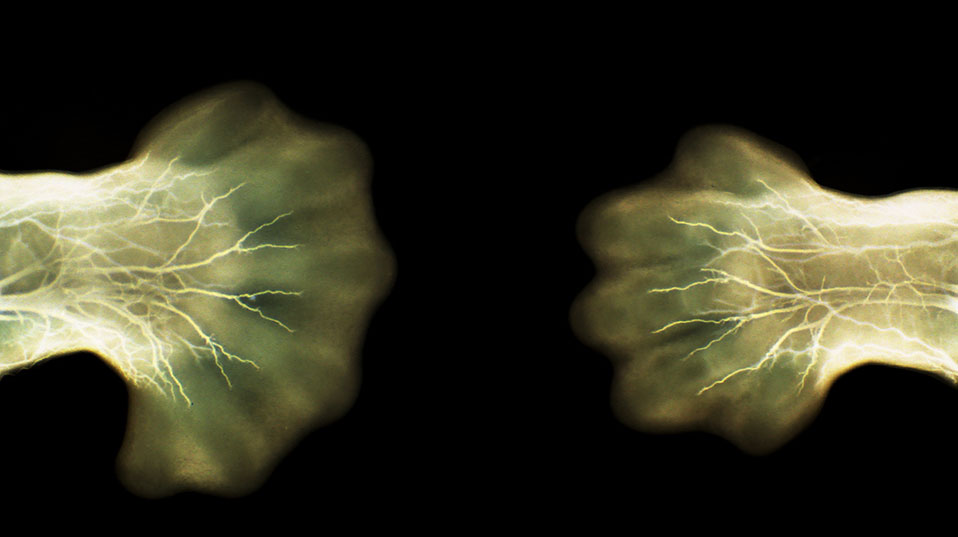More than five fingers is not possible – or is it?
Text: Yvonne Vahlensieck
Today’s vertebrates normally have no more than five fingers or toes on each limb. Biologists in Basel now want to find out why.
Paws, feet, hooves, wings – evolutionary biologists see all these body parts as variations on the same basic morphology, which has been optimally adapted to suit an animal’s way of life. Some of the original five fingers or toes are often lost during this process of adaptation. Thus, there are three fingers in a bird’s wing, an even-toed ungulate like a deer has two toes, and a horse runs on hooves perched at the tip of its single toe. Yet in spite of this diversity, it is surprising to find that there are no vertebrates around today with more than five toes on each foot. According to Professor Patrick Tschopp, a developmental biologist at Basel University’s section for integrative biology, «there seems to be a natural limit here.»
Again and again, however, there are cases of individual animals developing supernumerary fingers or toes as a result of mutations. This kind of hereditary polydactyly also occurs in humans (see box). In his research project, Tschopp is now investigating the embryonic development of these supernumerary fingers. He is mainly interested in whether they are fully functional – that is to say, whether they also develop the nerves and muscles needed for controlled movement. «We want to find out whether the neuromuscular system can adapt to the presence of a higher number of fingers. If not, that could explain why there is an upper limit of five fingers.»
Chickens and mice as experimental models
Tschopp chose the chicken as the model organism for his study. In doing so, he was following in a long tradition of developmental biology; more than 2,000 years ago, Aristotle smashed hens’ eggs to find out how they produce chicks. Modern-day methods are a good deal more sophisticated. The researchers carefully cut a small window into the eggshell, through which they are able to observe the chick’s development step by step. It is even possible to perform minor surgical procedures without harming the embryo. For their experiments, the Basel team implanted tiny beads soaked in retinoic acid in the wing bud of an embryo that was just a few days old. This caused the number of finger bones to double, so that the chick’s wings grew with six fingers, rather than three.
By staining different kinds of tissue, the researchers were then able to examine whether the additional fingers were establishing connections to muscles and nerves as they developed. Their analysis showed that the neuromuscular system is very flexible. Both the nerve fibers and the muscle cell precursors recognized the extra fingers, formed new branches, and grew on to the fingers. A series of tests carried out by Tschopp in collaboration with colleagues at the Department of Biomedicine yielded similar results. In a strain of mice with a mutation that caused them to develop more than fi ve fingers, muscles and nerves also formed on the extra fingers.
Connections in the spinal cord
The development of muscles and nerves does not in itself mean that the extra fingers are fully functional, however. «It is also important for the brain to be able to control the movement of the extra fingers independently of the original fingers,» Tschopp says. In the next set of experiments, therefore, the researchers want to find out how the nerve fi bers on the fi ngers are attached to the central nervous system.
This will involve researchers using a special staining technique to track the course of individual nerve fibers from the fingertips to the spinal cord. «There, all nerve cells that are under the control of the same brain cells and that control individual muscles are clustered together in pools,» Tschopp explains. «The question is, do the nerves from the extra fingers join an existing pool or form a new one?» If it is the latter, that is a strong indication that they are controlled independently and that at this level, too, there is no natural limit restricting the number of fingers to five.
The final results of these tests are still pending. However, if the neuromuscular system really can support more than five fingers, it raises the question of why nature has ignored this option up till now. Perhaps the negatives of having more than five fingers and toes outweigh the positives. People with polydactyly in fact usually have their supernumerary body parts removed for cosmetic reasons.
More articles in the current issue of UNI NOVA.


